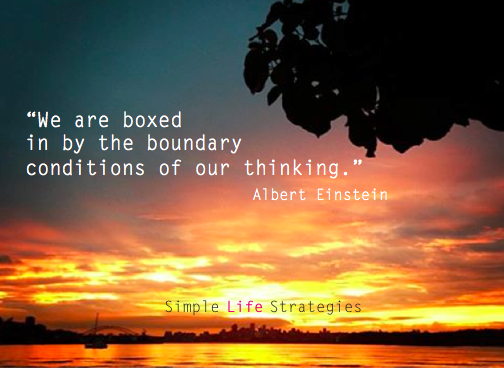Have you ever had a really, really annoying problem to solve and the answers just would not come? Have you spent days, weeks, even months trying to come up with an answer, only to be left feeling more confused the more you think about it?
I am very familiar with this! As a strategist my tendency has always been to over-think things and to analyze problems from every single angle imaginable. What I’ve found though is that this is a recipe for disaster. The more I think, the more my thoughts become tangled up into a quagmire of confusion, and the further away the problem often feels.
I’ve decided this year to abandon the complex in favour of the simple. I believe that simplicity demonstrates far more intelligence than complexity. As Richard Branson once said:
“Complexity is your enemy. Any fool can make something complicated. It is hard to make something simple.”
So, the good news is I have a really very, very simple solution to this issue. It’s almost so simple that it’s obvious – yet I know that most of us don’t do this. Because if we did, then we wouldn’t have the problem in the first place.
My initial inclination was to go into detail about why we have problems in the first place before divulging my solution. But in this case, I really don’t want to beat about the bush, I just want to get down to business and share what I’ve learned. Because believe me, this simple approach changes everything.
The one thing we do wrong
You see, there’s one crucial thing that we do wrong when we try and try and try to solve a problem. Just one thing. Not lots of things – just one single thing. Yet it’s this thing that sees us to-ing and fro-ing and getting stuck in the midst of our problem.
I bet you’re wondering what that thing is right? Well here goes:
We focus on the problem.
Simple I know. We focus on the problem. And by focusing on the problem, guess what we get? More problems. You see, the more we focus on the problem, the more narrow our thinking becomes. In-fact we box ourselves into the problem. Albert Einstein explained it perfectly when he said:
“We are boxed in by the boundary conditions of our thinking.”
What do you think you are likely to get if all you do is focus on the problem? Well I can tell you what you won’t get – and that’s the solution. If you think about it, deep concentration on a problem is essentially negative thinking. We are focused on what’s not working, or what is wrong. Research has shown that negative thinking literally blocks solutions. Our brains cannot operate effectively when we are coming at something from a place of negativity. So, we literally box ourselves in and stop the solution from arriving.
Conversely, if we focus on the opposite of the problem, what the solutions might be, we open our minds to all sorts of possibility. We create options for ourselves.
Think back to the last problem you grappled with? What were you concentrating on in order to fix it? Were you getting stuck on the problem its-self? Or were you able to detach yourself from the problem and consider solutions?
Use language to your advantage
Once you get this way of thinking it will literally change the way you solve problems. The good news is you can use language to your advantage. Instead of saying this like:
* “why won’t this work?”
* “what’s wrong with this?”
* “This isn’t working”
Try saying things like:
* “I wonder what would happen if…”
* “What solution can I come up with?”
* “Imagine if we did this….”
Can you feel the difference between these two approaches? One will drag you further into the problem and the other will lift you up out of the problem!
The law of flotation
The scientist Thomas Troward once said that “the law of flotation was not discovered by contemplating the sinking of things. Rather, it was discovered by thinking about things that float naturally.”
Consider this for a moment – it is not possible to find the solution by focusing on the problem! We must think laterally (sideways) like Thomas Troward. We must gain inspiration from others who may have grappled with a similar problem, we must look for ways that our problem has been solved in other industries, we must do anything except focus on the problem its-self!
Did you know that Henry Ford did not come up with the idea of the assembly line, neither did he found the Car company Ford? He simply looked at the idea of the assembly line as originally used in the meat packing industries and borrowed this for the automobile industry! This is lateral thinking in action. Try it. Leave the problem behind and focus on the solution.
Simple Life Strategy: A Simple 5 Step Problem Solving Strategy
1. Become aware. What are you focused on? Are you getting caught up in the problem its-self?
2. Note your language. Is it positive or negative? Is it helping you or hindering you?
3. Decide to not focus on the problem. Make a conscious decision to move away from concentrating on the problem.
4. Think laterally (sideways). Consider how others may have tried to solve the problem? How have other industries, or other countries dealt with such problems? Can you apply this thinking?
5. Search for solutions. Come at the problem with solutions instead of getting stuck on what is wrong or missing.
If you enjoyed this post, please share it with others.
More Simple Life Strategies:
PS ~ Sick of working just to pay the bills? Get my most popular, FREE online training here: My 3 Step process To Find A More Meaningful Career.
Join 108,000 beautiful souls on the Simple Life Strategies Facebook page to get access to articles before anyone else!




“Overthinking” involves words. This articles seems to rely on intuition, which is largely dependent on experience. Without adequate experience it may be hard to recognize that there is a problem, or its origin. What constitutes “adequate” experience? That depends on the “problem.” Alzheimer’s disease is a complex problem which won’t be solved without extensive analysis, experimentation and perhaps some intuition.